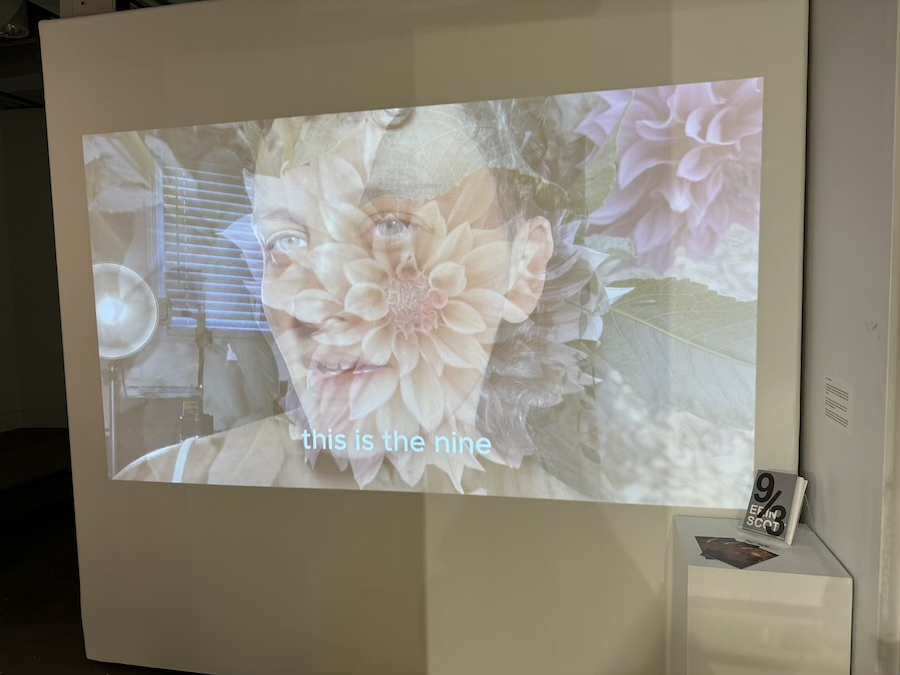2021 BFA Graduating Exhibition – Up Close from a Distance
Each spring, graduating visual arts students at UBC’s Okanagan campus prepare a final exhibition as they complete their program. This year’s Bachelor of Fine Arts (BFA) show, titled Up Close from a Distance, is shared as a virtual exhibition.
The BFA exhibition highlights a wide variety of work created by 18 emerging artists during the course of the year. The collection includes sculpture, performance, installation, painting, drawing and animation.
Adrianna Singleton
Drawing has become a therapeutic ritual to express what I cannot verbally explain. My drawings are raw like the wounds of my mind. They make me want to be as vulnerable as I can and dive into the root of my issues, stripped naked as I try to find the right clothing.
I use canvas that has been torn from a larger cloth with the edges left raw. My process entails hours dedicated to covering my hands in charcoal, dripping paint onto the floor, and immersing myself into what seems like the room from the film, A Beautiful Mind, finding connections from every moment that brought me here. The black lines I paint represent the utter agony of having a mental disorder, and I am often lost in a distorted reality that fills my mind with delusions I cannot unsee. The figures I make feel heavy to move and helplessly stuck in an abyss that is thickened with the lingering of my past.
I work large to let my entire body flow to the rhythm of the piece; my arms tired, covered in materials as if the drawing and I wrestled until both of us were spent. I burn through sketchbooks as they see me through a non-judgmental lens where I can lay down my circling thoughts and put them to rest. I place my figures in a liminal space of uncertainty, trapped inside myself, unsure of my last decision and unsure of my next. I want to change the way I used to turn a blind eye to fragile feelings. I want to be an activist to find peace in chaos.

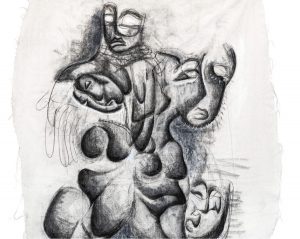

AJ Salter
“Where Did You Get that Coat?” is a performance project in which I wear an obviously handmade coat and record the conversations that wearing this clothing initiates. The coat is white and blue with hand dyed panels. These contrasting panels attract attention to the coat’s construction and emphasize some of the common features used to custom fit clothing, including gussets, godets, gores, and princess seams. Though common in handmade clothing, these features are often absent in mass-produced fast fashion. When people engage with me on the street and ask “Where Did You Get that Coat?” A conversation ensues. My goal is to educate people on the benefits of basic tailoring, to interest people in sewing, and to help promote higher expectations from fashion.
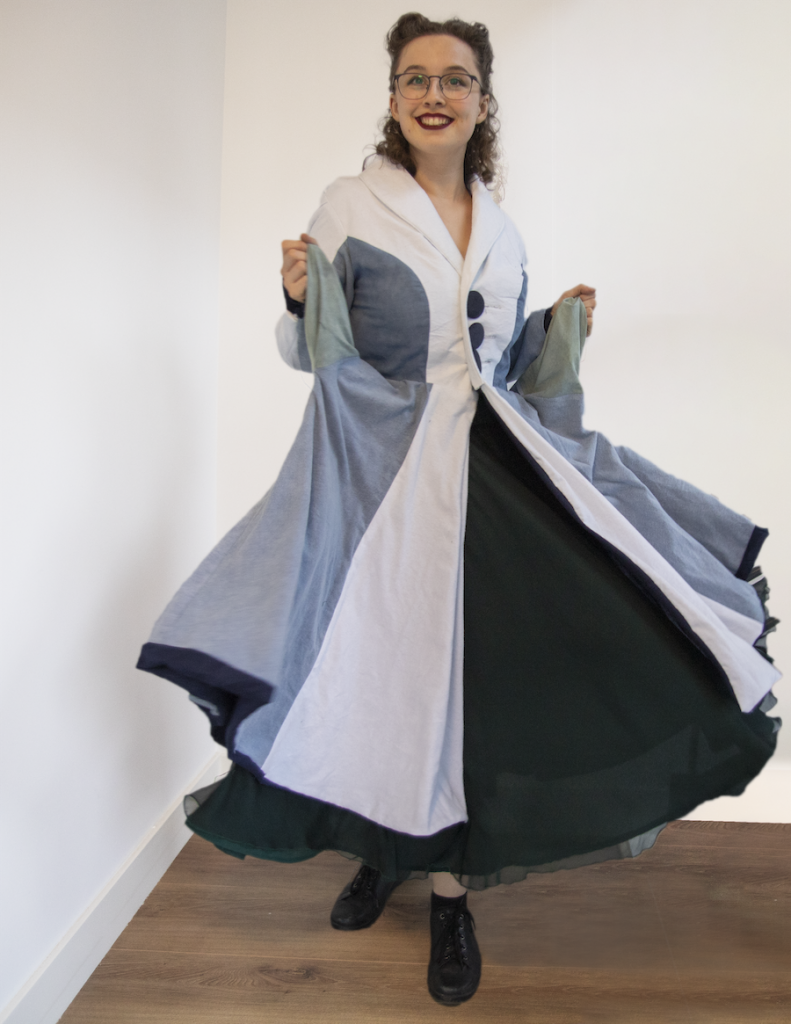
Amily Wang
Family Portrait is a series of digital watercolor drawings that explores how family violence affects all family members, especially from a child’s perspective.
In my drawings I seek to depict the emotional landscape of family relations and show the individual experiences of each person. For example, in one drawing the mother character is facing a different direction and hiding her emotions while the other family members look ahead. Throughout the series there are various meanings to be found in the background imagery and objects that help to convey my intended narrative. The opening of a classical Chinese screen symbolizes an ‘exit’ to walk away from the family. The pictures behind the little girl represent her understanding of an ideal marriage. Patterns and decorations also have different meanings in my work. The embroidered bamboo patterns symbolize the father’s obstinate personality, and the blooming floral patterns on the young girl’s dress symbolizes her hope for peace within her family. Most importantly, these images portray how children see family violence.
Women’s social status and feminism have become topics of concern. Feminism is not only about national politics but also a symbol of the progress of human civilization. According to a Chinese government official website, 24.7% of women in China have suffered from abuses, beatings, restrictions on personal freedom, economic control, and other forms of family violence throughout their marriage.
In this series, children’s vision has been shown as an important element. That is because if a child is born in a family that experiences violence, they will be at risk of growing up to continue these behaviors or they are more likely to be insecure because of their childhood shadows. This project also reminds people to avoid family violence because children are always watching their parents. This series of drawings also incorporates elements from my childhood memories. It explores the feelings I used to have when violence was a problem in my family.


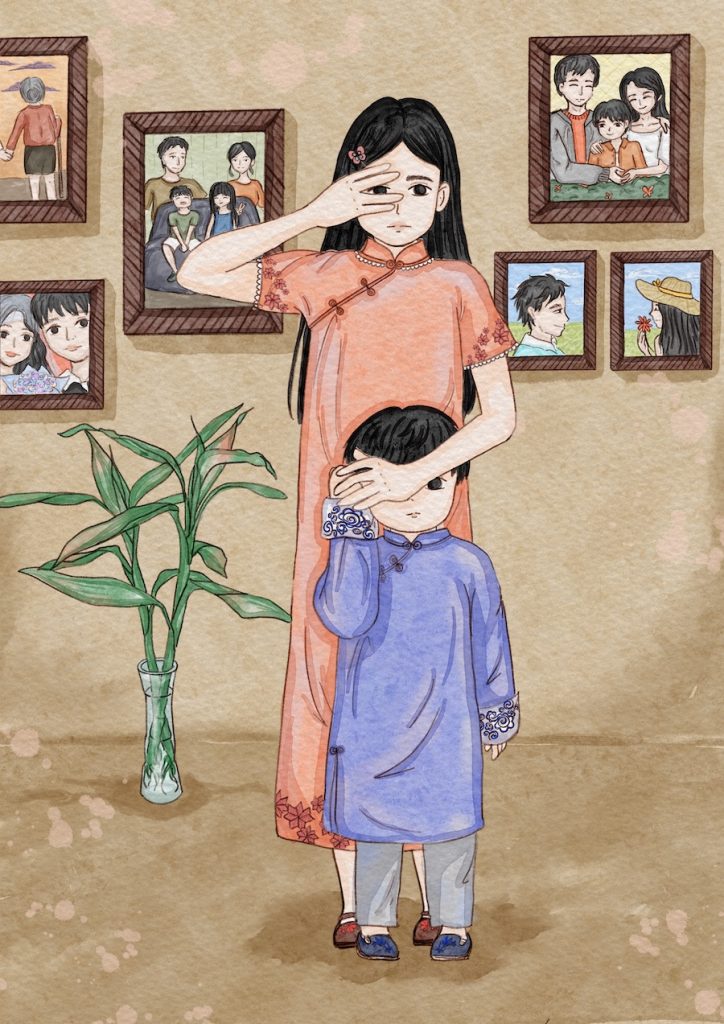
Amy Hanfstingl
Most people feel a connection with animals, a connection established through their pets or through experiences in nature. This series emphasizes those moments of connection between animals and humans when eye contact is made. By capturing these moments and emphasizing the physicality of the scene through the heightened expression of texture and colour, I aim to create a momentary relationship between viewer and animal.
My inspiration for this series of digital paintings is based on my experiences camping in British Columbia’s fragile wilderness. Through these pieces I emphasize their environment by placing the animals in this simplistic landscape. Through the viewers interpretations, these backgrounds can be viewed as different places. By taking a closer look at these pieces it creates a small moment between the viewer and the piece. Our local wildlife and its preservation is more important now than ever. Through this work I hope to create a momentary shift in the viewer’s train of thought in order to bring their attention to the precious wildlife around them.

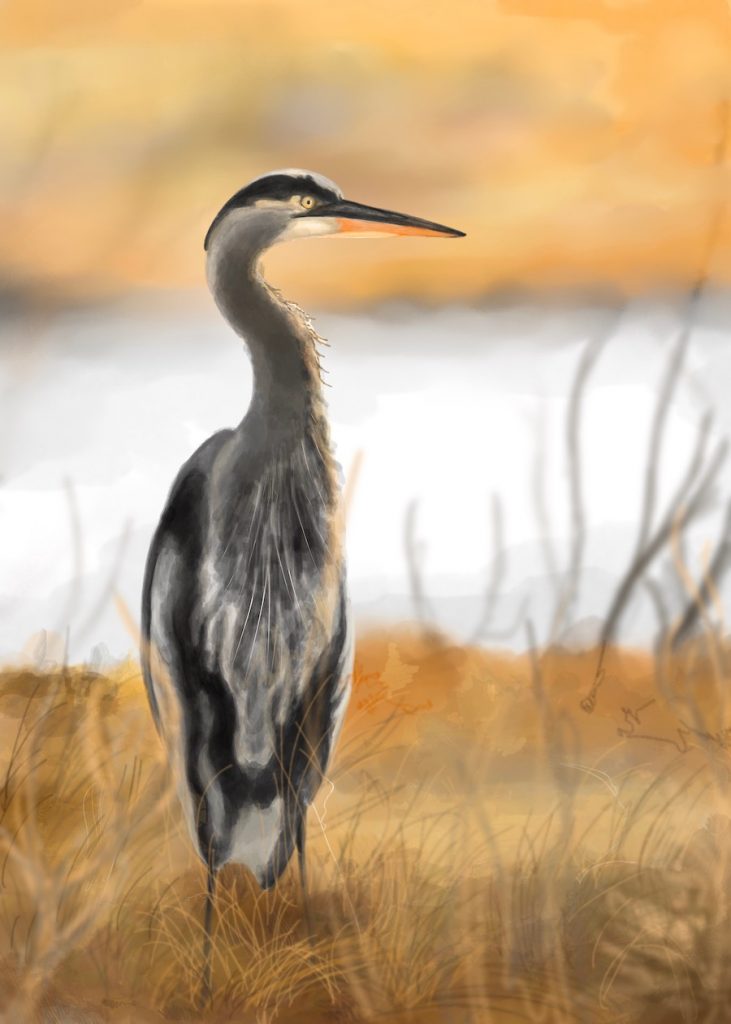
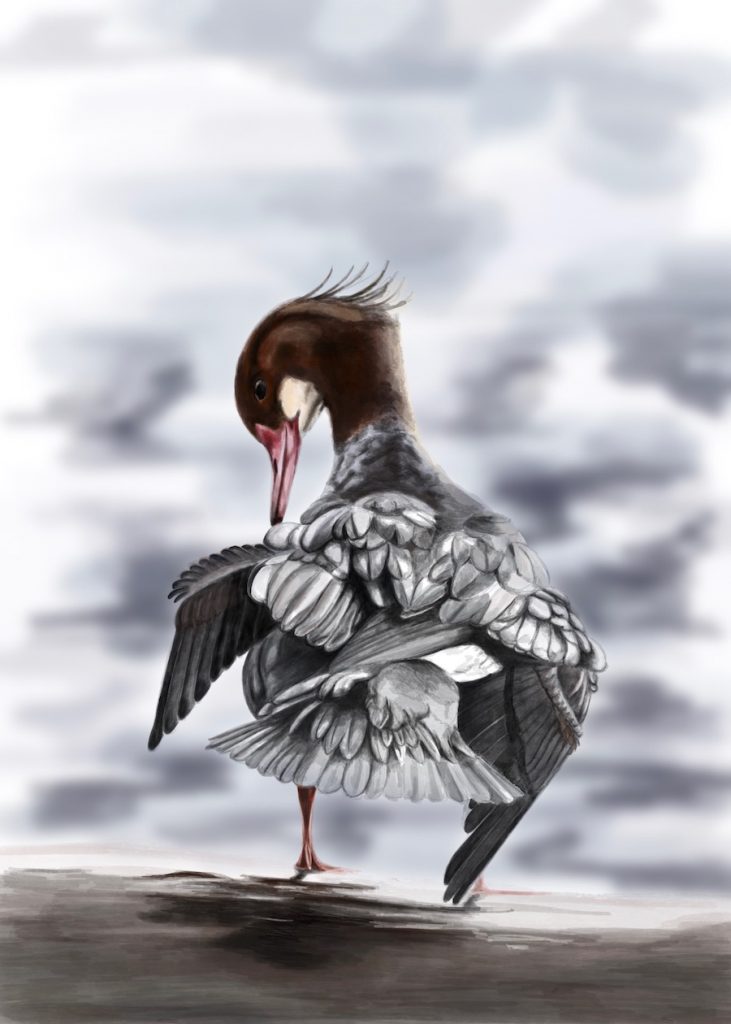
Arianne Tubman
My work investigates Canadian gun culture through documentary photography. This series looks at hunters, who make up the largest demographic of gun owners in Canada. By engaging with hunters and documenting their experiences I am attempting to create a holistic portrait of this community. For some, hunting reflects their connection to the land and for others it is a way to provide for their families. Regardless of their motivations, the subjects of these photographs are united in their love for the natural world, and their interest in using guns as a tool of choice.
Canada has a federal gun licensing program run and monitored by the Royal Canadian Mounted Police. The rules surrounding firearms in Canada regulate who gets to possess guns and outlines the steep penalties for using them irresponsibly. However, regardless of these regulations and the extensive background checks that law-abiding citizens go through to own a gun in Canada, the influence of American media negatively shapes our perception of gun owners as dangerous and violent individuals.
Through these photographs I represent the firearms community in Canada in a way that is honest to their experiences; both the serene and the severe. I hope my work challenges people’s perspectives on firearms and hunting and also creates opportunities for informed discussion about gun use in Canada.


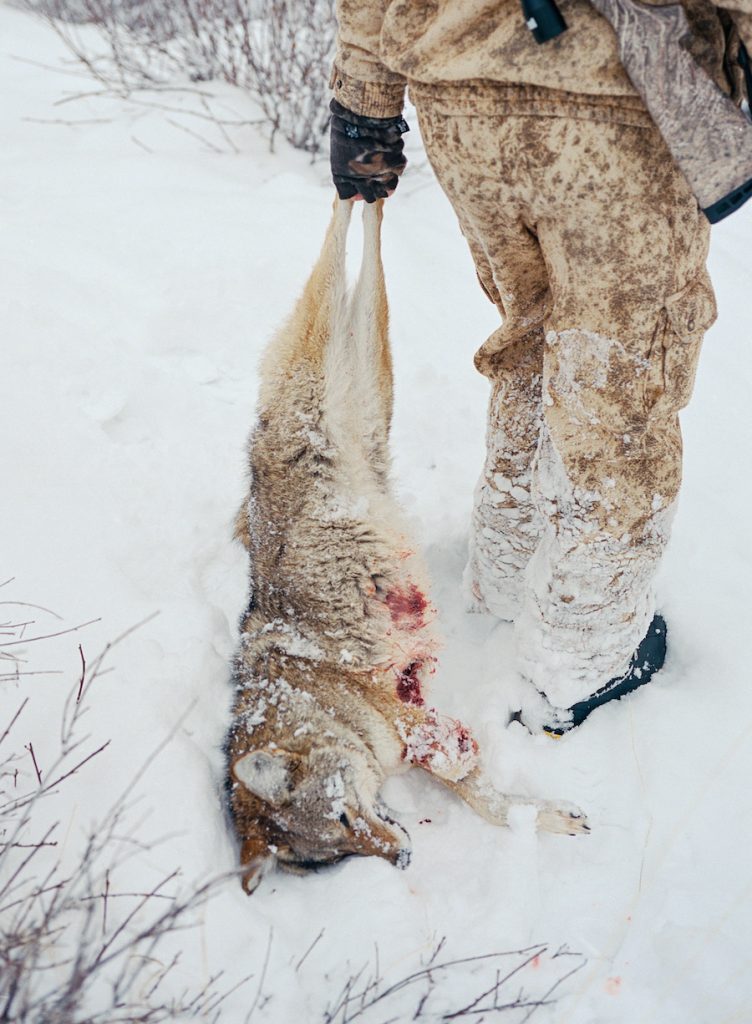
Bronwyn Maddock
Art can be seen as an extension of the artist creating it, whether it be created out of past experiences or what they see for themselves in the future. These works were created out of humour and thinking in terms of the everyday aspects of life. I leaves space for viewers to interpret my paintings and perhaps see themselves reflected in the images and narratives.
The ‘skeleton’ is a reoccurring subject in this series of paintings. Unless you are an expert in anatomy, you won’t be able to tell the gender of the skeletons that are depicted in my work, and that’s the point. At the end of the day, we’re all just a skeleton underneath. You are able to see yourself in the work in whatever way you feel is the best. I chose to paint these everyday aspects of life which will evoke different interpretations by viewers.
I have always been highly influenced by the Baroque period and the techniques that were used when playing with light and space. Rembrandt’s works are the greatest inspiration when it comes to the study of light, colour, measuring the space and creating movement within the composition. Light plays an important role in my work as it sets an interesting mood in each scenario that has been created. I hope these works will encourage viewers to think about their lives, the highs and lows.
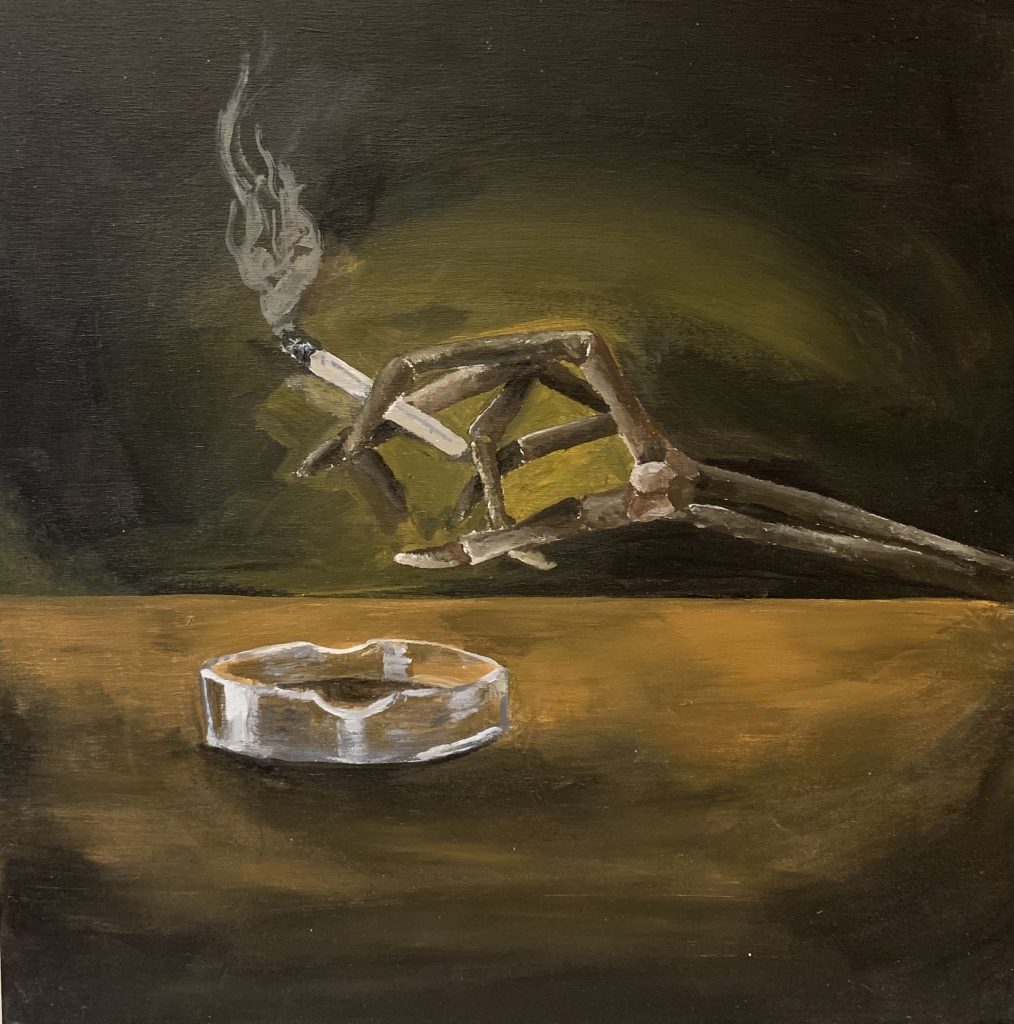

Coralee Miller
I am a Syilx (Okanagan) artist who portrays cultural pride through my paintings. I gain inspiration from my family and the oral stories from my community. I explore oral stories as a way of looking deeper into Syilx cultural values and bridging their moral lessons into a modern day understanding. I focus on moments of humour and the importance of humility through the ever boastful and immortal trickster spirit, Senklip (Coyote). What I take from the Coyote stories is the importance of identity, being true to ourselves and remembering that we are all fallible. In Syilx belief, people are part of an interwoven relationship between the land, water, animal, and spirit. I do my best to portray this relationship in my paintings by depicting scenes of connectedness between the natural world and the spiritual.
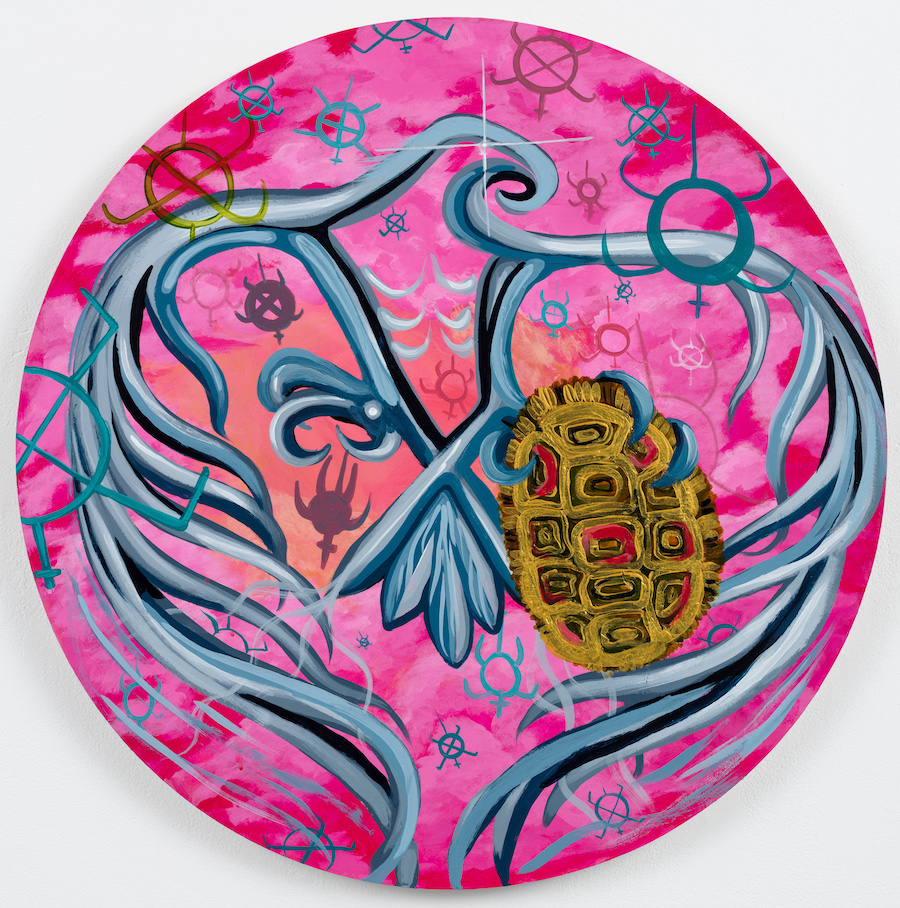

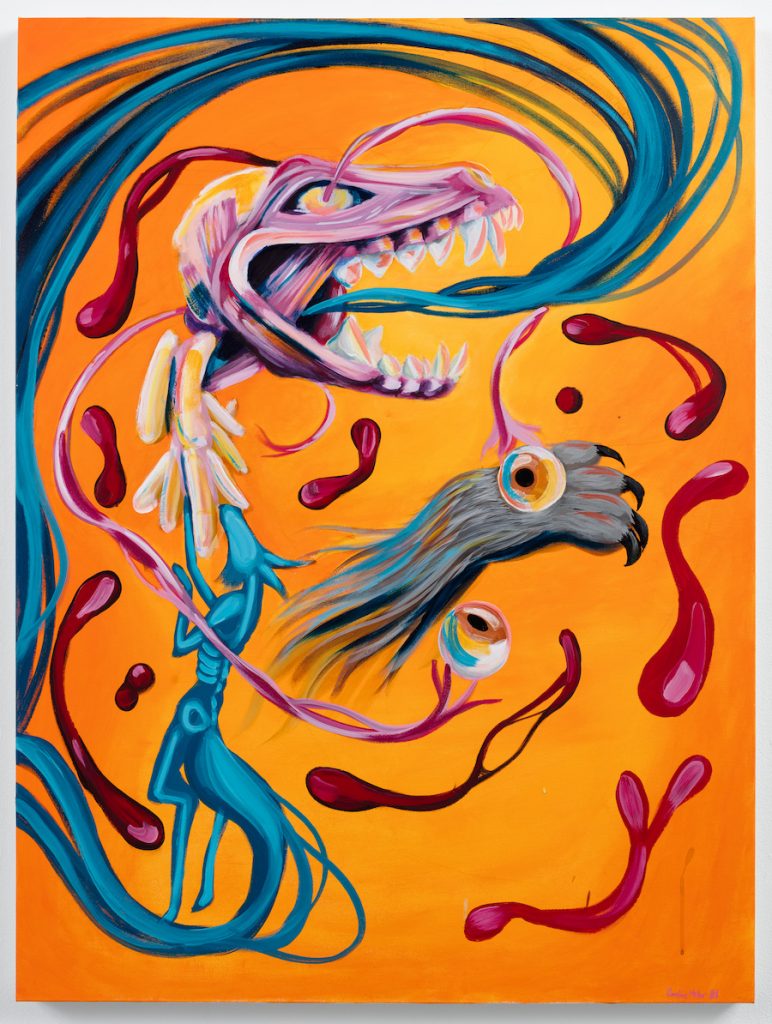
Dillon Eichhorst
Virtual Distancing is an interactive digital experience commenting on the feelings of anxiety during the current COVID-19 pandemic. The installation is comprised of a dynamic animated projection of particles that track motion using a mounted camera, as well as audio using an external microphone. When interacting with the work, it is my intention for viewers to consider their own experiences with the pandemic and how it has affected their behavior and interactions with society as a whole. I am very interested in how new media can bring a viewer or an audience into a fantastical world physically different from their own, and as an artist, I can harness this to draw parallels with the world we live in.
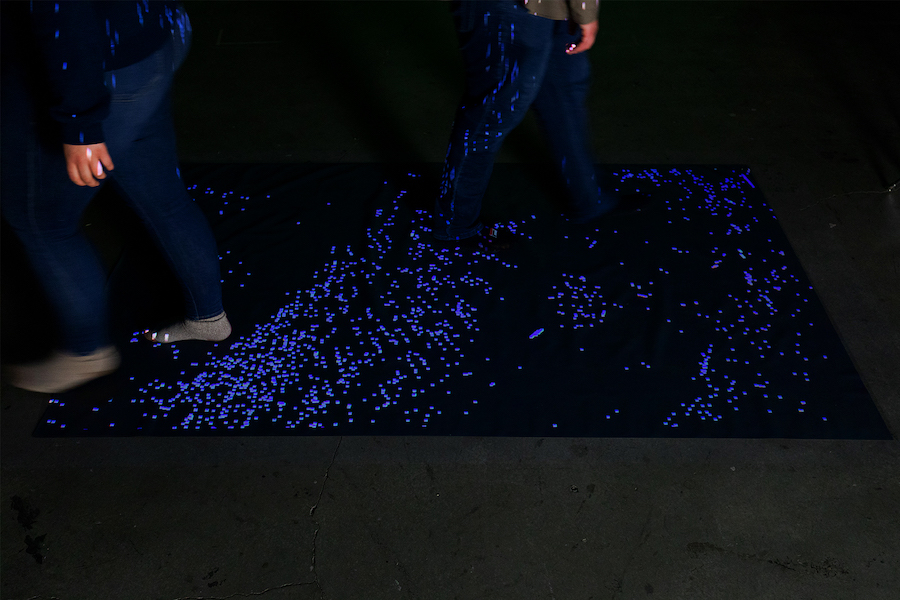
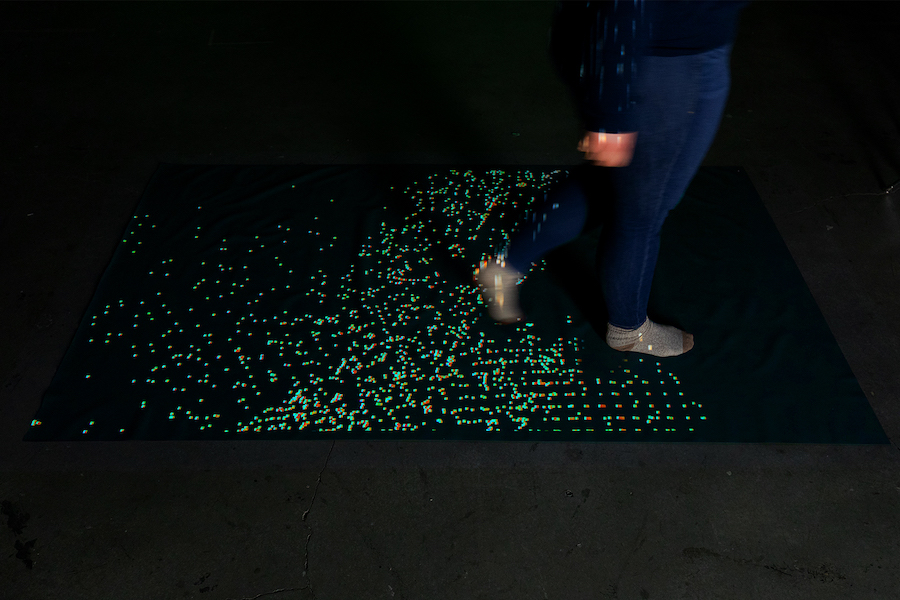
Faith Wandler
My greatest enjoyment comes from creating pieces in a conceptual manner that also includes the use of craft. I like to focus on my own inner anxiety and repetitive thoughts that end up controlling my daily life in a negative way. The use of ‘journal therapy’ allows for someone to focus on their internal experiences, overbearing thoughts and feelings by putting them into a tangible physical form instead of holding them within and allowing them to have control over one’s wellbeing. I use the idea of journal therapy through the repetition of words or short phrases that are weighing me down and creating significant anxiety in my life. The only way I feel that I can rid these toxic thoughts from my mind is by bringing them out visually. This allows the meddlesome words to be released from my mind and into the work, therefore becoming a tangible piece that viewers can connect with and hopefully relate to their own inner anxieties.
The use of repetition is also very prevalent in my practice, whether it be how I physically make the piece or the visual aesthetics that are being shown. This method of working shows the effects of my generalized anxiety disorder and how repeated thoughts are often weighing me down. However, repetition in my daily routine also gives me great comfort. My artistic process relates to my daily process of dealing with mental illness, and constantly working on my wellbeing is a never ending journey.
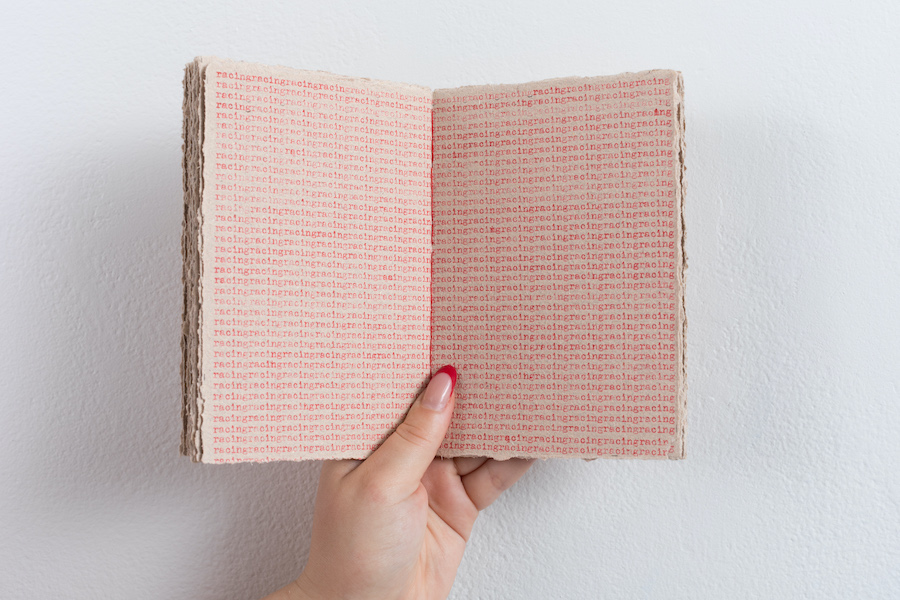
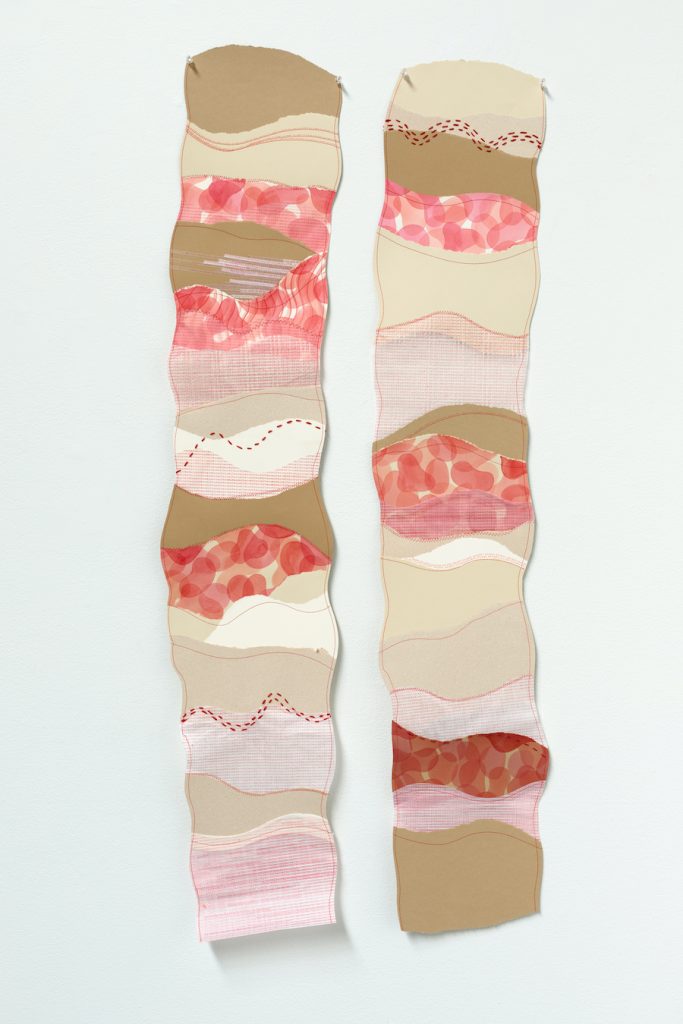
Jade Zitko
I find painting remarkable. Colour, line, form, shape, brushwork and liquidity are the painter’s tools, and they are both certain and unpredictable. With these tools I strive to express how I experience the world around me. For there are many interesting materials presented around us. While I often begin a painting by studying a particular object or constructing a model, feelings and emotions are also starting places. Abstraction has the capacity to represent the unique characteristics of an object. Such as the shapes found in the reflection of a glass vase reveals the finer details of its structure. The ability to build up paint makes it possible to convey emotions for they are not something that has just one layer. For instance, representing the calmness I feel sitting outside on a sunny morning. The passion in the process of creating makes for a memorable experience.
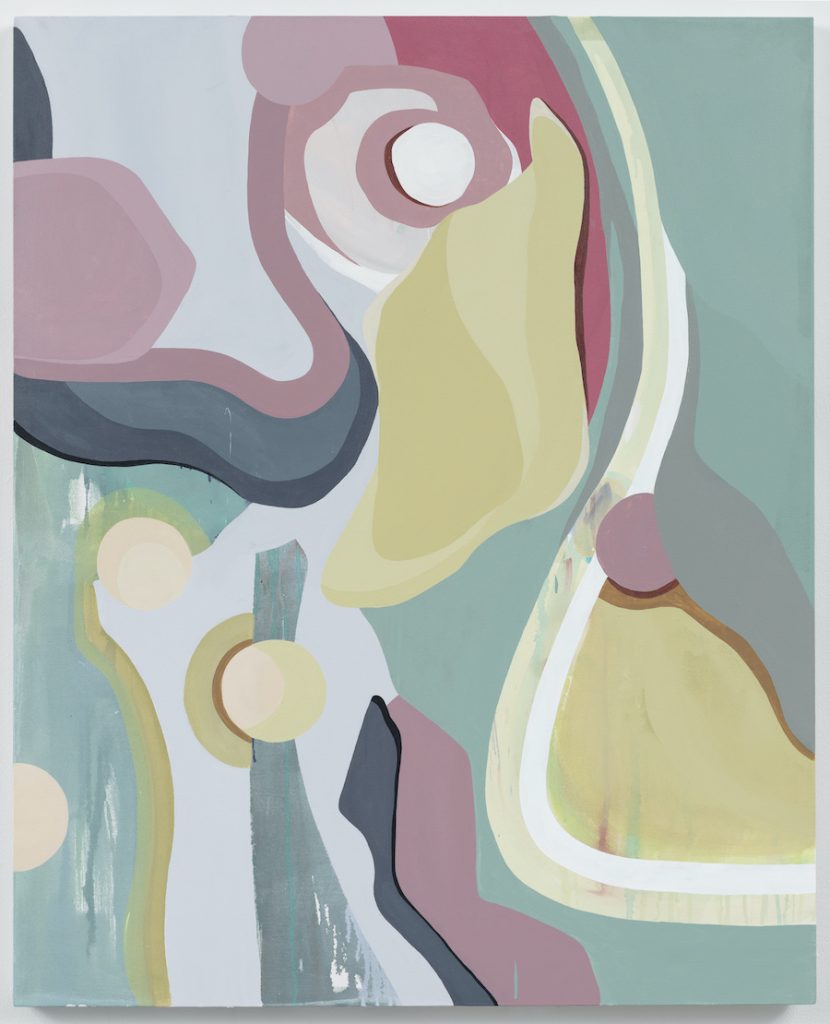
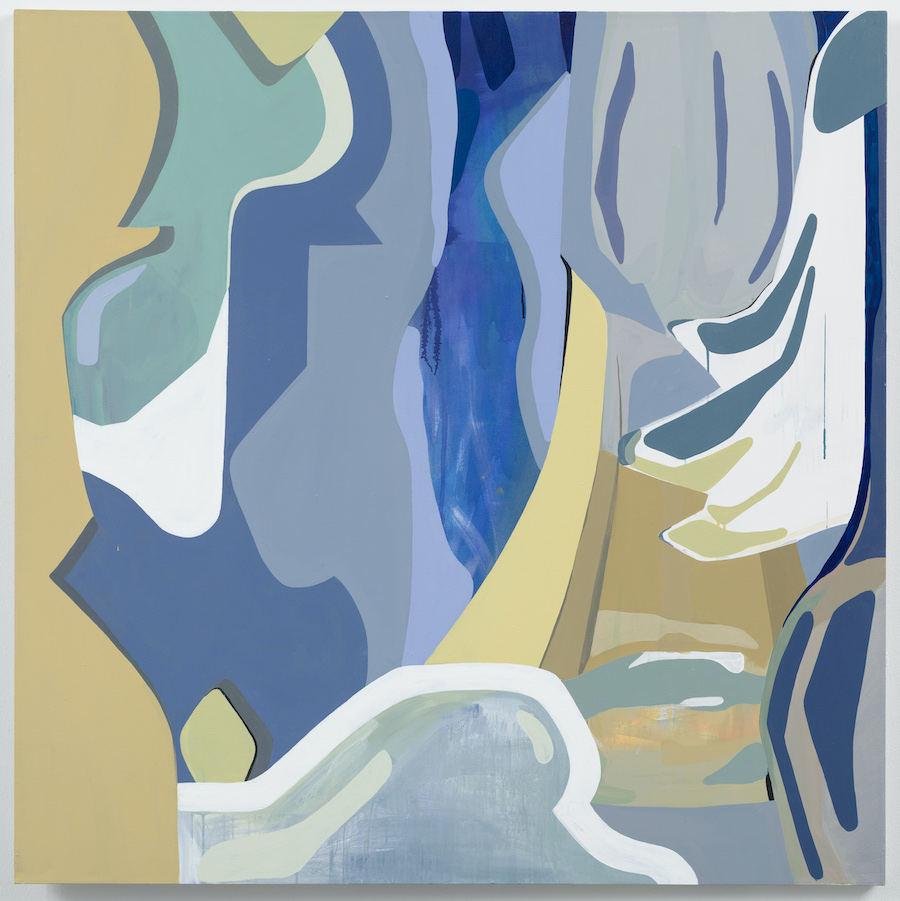
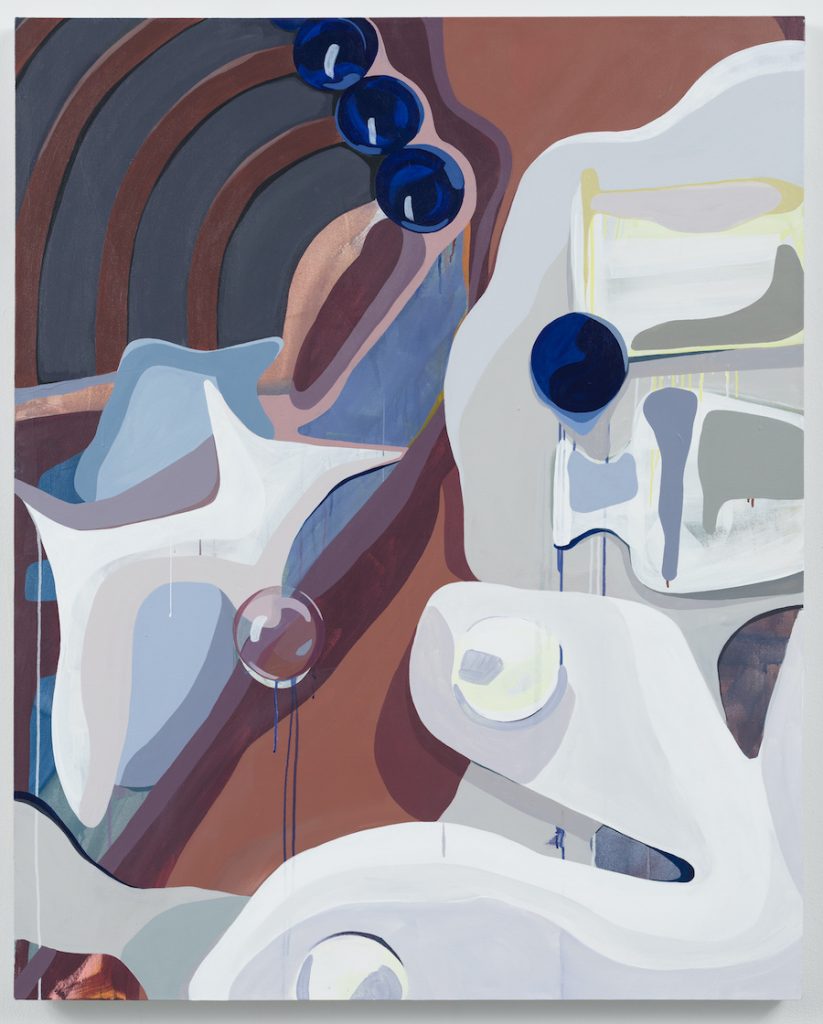
Lareina McElroy
The natural world is full of magic moments, even in the most common places. This series of paintings, set in rural Saskatchewan, reimagines my childhood memories and seeks to capture the emotional expression of the prairies and their melancholic skies. There is a hidden beauty in Saskatchewan that is often overlooked. There is also a sense of desolation in the vast fields of crops, thunderstorms, abandoned farm houses and barns. In this place a female figure, whose distant expression suggests contemplation, is accompanied by animals who offer comfort. These are narratives constructed on beauty and desolation in equal parts.
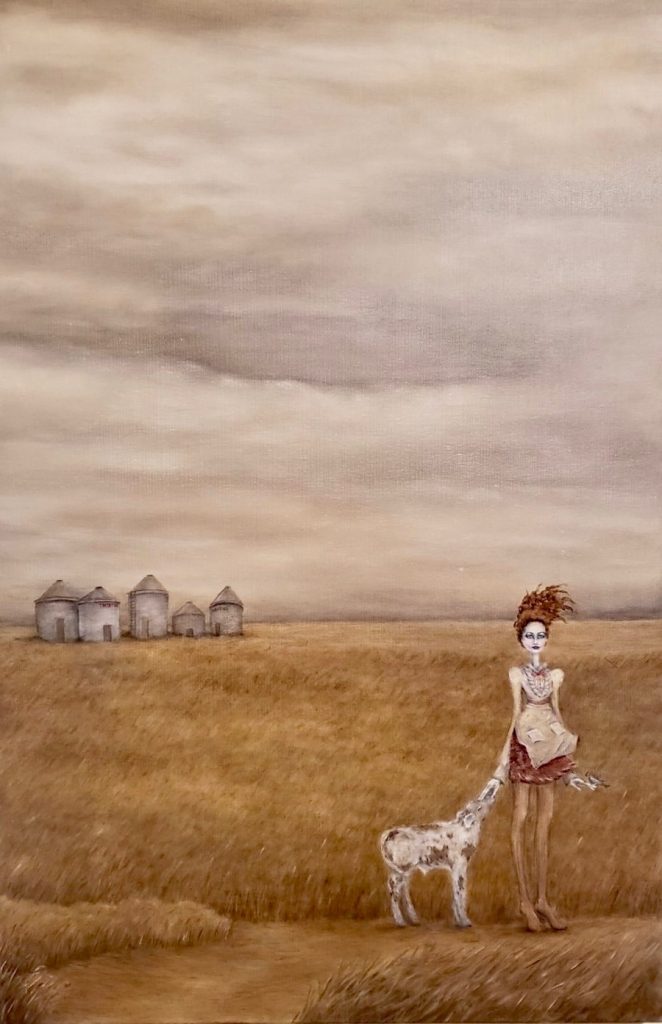


Pip Mamo Dryden
The home is the site of many of the most intimate moments of our lives. As suggested by Gaston Bachelard in his book The Poetics of Space, each area of our home is charged with memories, each room contains a different time. In this piece, I am examining one of the most intimate spaces in my memory: the dining room.
As someone who has suffered from anorexia nervosa from a young age, the dining room is the site of my fears, hatred, anger, and pain. These feelings are shared by many of those affected by eating disorders, insecurities about body image and anxieties brought about by diet culture. The dining room is also the place where families come together. Aside from just holding memories, homes are the sites of our relationships. My work examines the effects of anorexia and mental illness on the family.
At either end of a long, fractured table, two chairs sit, each functioning as a representation of a person. One is made of felted raw wool, shaped from something soft into something hard by the repeated violence of the felting needle. The other is cage-like, made out of chicken wire and barely visible. Between them stretch seven tables, each set with a tableau of tableware bound with thread and beads, rendering the objects unusable. In the center sits a large white cake under a glass dome. Making a cake for one you love is an act of care and celebration, but this cake is inedible, trapped under glass and growing mold. The slow decay of the cake is a marker of the time these two people have spent at this table, and functions as a symbol of their decaying relationship. The stark white colour scheme of this work emphasizes the objects and their materiality. To me, white is representative of the void, of silence, and of frozen things. In this piece, the two figures have been frozen at their dinner table, stuck in a silent, painful standoff.
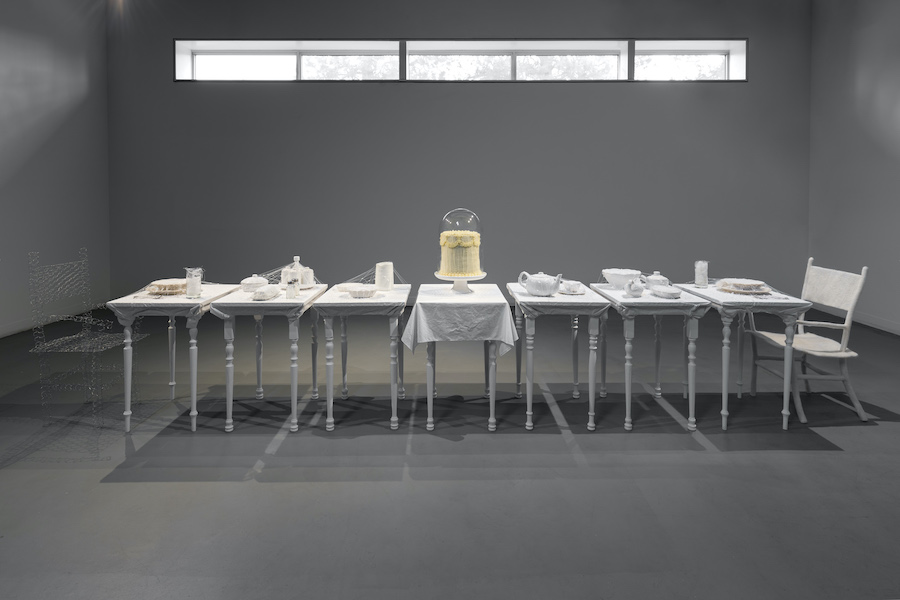
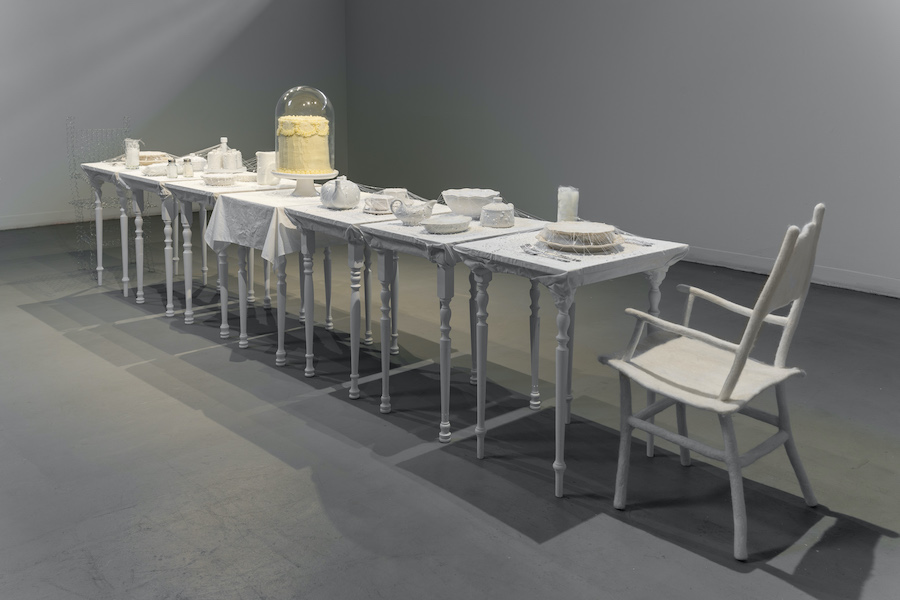

Reuben Scott
I create large-scale paintings that depict comedic scenes of mundane every-day events. These situations are loosely based on real experiences that were unremarkable, yet they stuck in my memory because they were funny or odd and were worth sharing with the viewer.
My style of painting is influenced by the cartoons that I saw in books and newspapers as a kid. When I was younger, I tried to replicate them and I took cues from how they drew bodies and forms, the humour they use, and the ideas they explore. I combined these elements together into my own personal style. It is my hope that through painting I can elevate these every-day scenarios and the popular art form of cartoons into something that is engaging and could be enjoyed by the gallery patron and the comic book fan equally.
I am specific in how I place these characters in their environments in order to find the hidden resonance that plays out in their every-day turmoil. The participants are experiencing an issue or struggle. The nature and the relative unimportance of these struggles is where the humor lies in the finished painting. In the end I want to isolate and focus on the events that all people experience and reveal the humorous qualities to make art that eases the strife that people experience in their daily lives.
Sage Cannon
Conversion therapy’ is a pseudo-scientific practice that is used to change a person’s gender expression or sexual orientation. Except for some provinces and cities, this harmful practice is legal across Canada. The Canadian government is currently discussing an amendment to the criminal code (Bill C-6) which would make conversion therapy illegal.
Conversion Therapy: Carry It With You is a public performance in which I carry a backpack that is filled with rocks through downtown Kelowna. During the walk I pause to unpack and repack the rocks to give pedestrians space to observe me and to interrupt their routine. The act of unpacking and repacking serves as a reminder to me of how many people conversion therapy has affected. The performance is an hour long as I want to endure a portion of the burden that others have as a way of furthering my understanding. When strangers engage with the work by approaching or talking to me, I hand them a business card with a QR code linked to an audio-recording. The audio includes sections of Bill C-6 combined with an interview from the Human Rights Campaign that inspired my research.
As a lesbian woman I am interested in exploring my community to further understand my identity. After researching the history of LGBTQ+ experiences, I discovered that conversion therapy continues to be practiced across North America, which was surprising as it is not well-known. Although Canada is seen as an accepting country for LGBTQ+ people, the law is simultaneously harming the same community and trying to ‘fix’ them. This performance is a reminder that there is still work that needs to be done to protect LGBTQ+ people, especially youth. With this work I hope to start an open dialogue about conversion therapy.
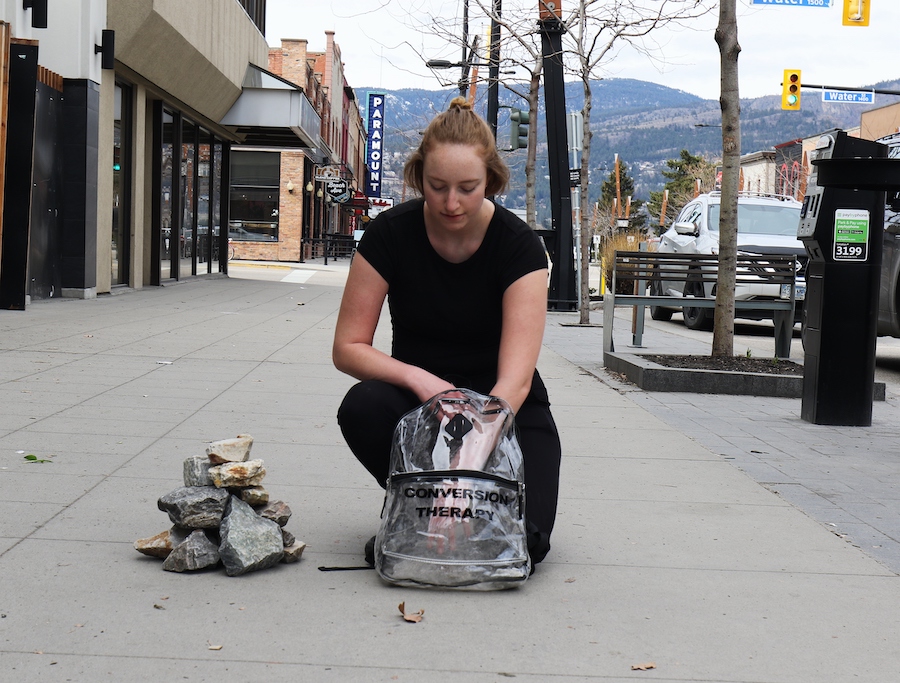


Sidney Steven
Breaching Out is a short hand drawn and digital animation that depicts a journey of transformation through the perspective of a whale. I have a close connection with whales from spending time observing these animals on whale watching trips, and because they are mysterious animals. This story depicts a whale’s journey from a dark and lonely place into a place of colour and freedom.
The narration is my own voice and along with the setting, it helps to capture the emotions at the heart of this journey. Growing up, I went through a difficult process of understanding myself. I experienced lonely times on my path to self-love and self-acceptance. My goal in making this animation is to help others understand a snippet of my thoughts and feelings. I was also motivated to create something positive in response to the increase of mental health awareness and loneliness. Nobody truly knows what is going on inside someone else’s mind until that person can say it aloud. I hope that this story brings comfort and helps us all relate to one another.



Stephanie Tennert
Mitochondrial DNA is a separate DNA sequence that exists solely in the mitochondrial organelles. This sequence is only passed down through the mother, creating a long ancestral line that can be traced back for not only generations, but thousands of years. This DNA sequence is what unifies my series of portraits which are all colour coded drawn representations of the matrilineal members of my family.
In this series of illustrations, maps are displayed over each portrait signifying the memories of these spaces being stored away in their psyche. Each portrait is represented with strong colours that relate to the subjects’ personalities and the environment being depicted. I believe that geography can act as a vehicle for exploring memory and how a space can become part of one’s identity.
I chose to centre my work around this as a way to connect to my mother’s Brazilian heritage while exploring my own cultural identity. As a first generation Canadian, I wanted to fit in with the culture that surrounds me, but also at home. This conflict of being caught between different cultures resulted in never learning my mother’s language which left me with feelings of disconnection and exclusion.
Feminism is a cornerstone of my project. It emphasizes the importance of female figures, just as I want to emphasize the women in my family, their stories, and foster the connection with my maternal lineage.
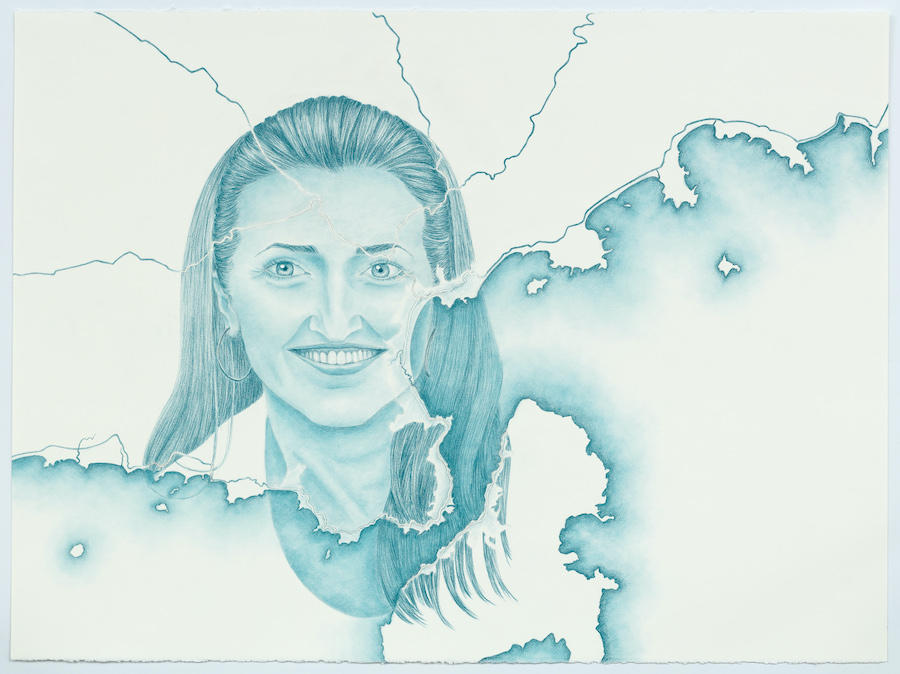
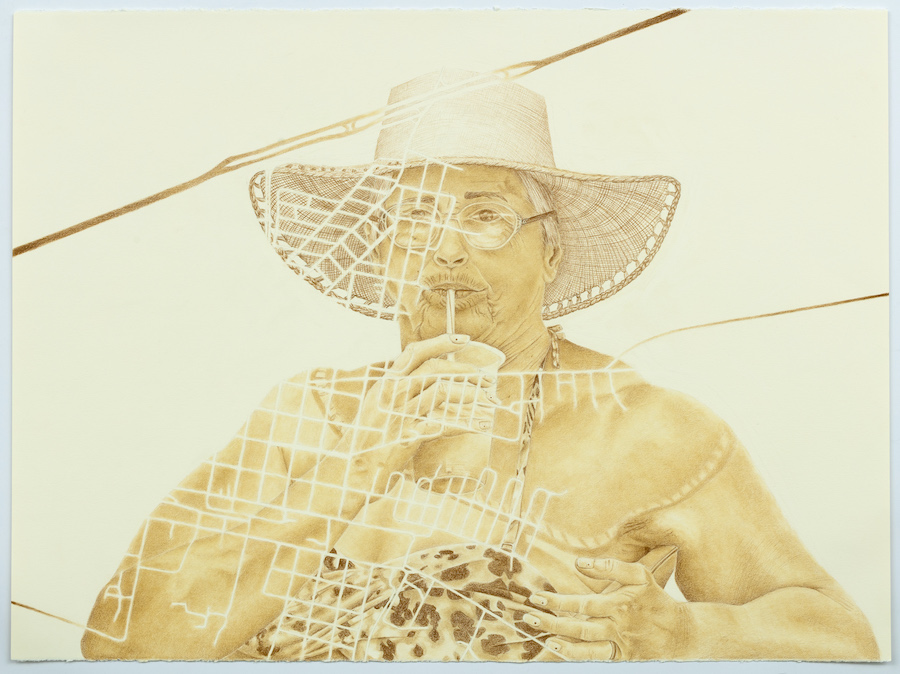
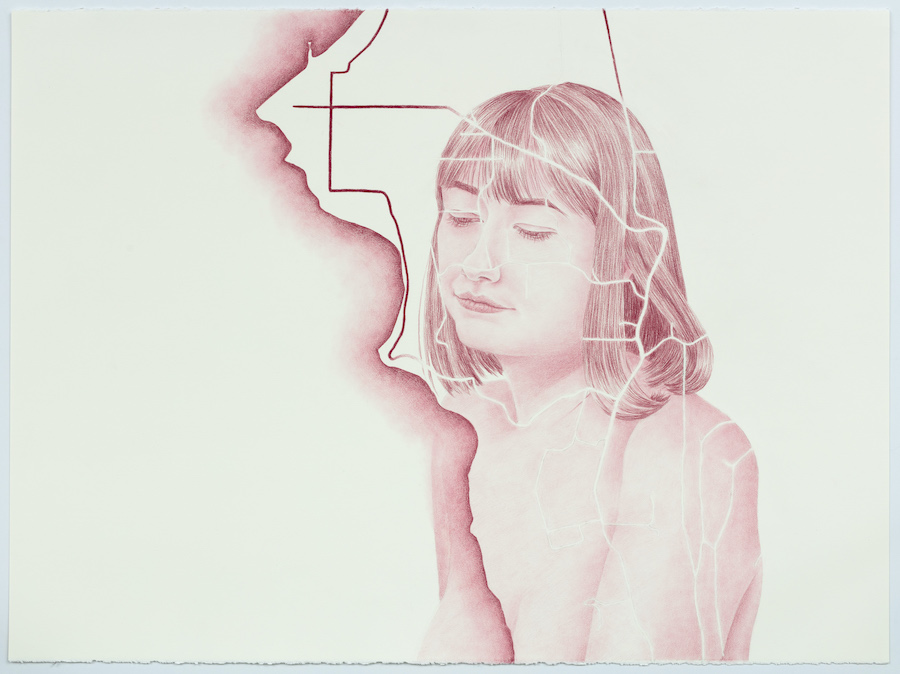
Tiffany Douglas
This series of paintings on log cookies reflect the natural world around me and my spiritual connections to it. This collection of wooden ‘canvases’ are painted with abstract shapes and colour palettes directly influenced by nature’s vibrancy.
A log cookie is a cross section of wood cut from a tree where you can see all the tree’s rings. These were cut and harvested by my brother in law who is a logger. I like to think of this as a collaborative process between a tree, a logger, and an artist. In this body of work, I want to reflect upon the material’s importance by highlighting its patterns and textures through abstract marks and shapes. The various colour schemes in each of the paintings reflect the magic of the natural world.
I am deeply inspired by the changing seasons, local flora and fauna, and the magic within the forest. I had moved back to my hometown, Lundbreck, for a year while creating these pieces and this informed their materiality and process. Because it is a rural location in Alberta, (nestled at the foothills of the Rocky Mountains and the Prairies) I was surrounded by so many different types of landscapes that I had grown up seeing.
The colour scheme is pulled from magic that surrounds me within nature and is a way to show the native plants, elements, and animals through abstract marks and shapes. I feel very connected to my spirituality when I explore nature. I found that by creating these pieces, I was able to connect with natural elements and spirituality in a different way than just experiencing these settings firsthand. When making this series I found out more about myself, my spiritual journey, and meditative states by creating with nature.
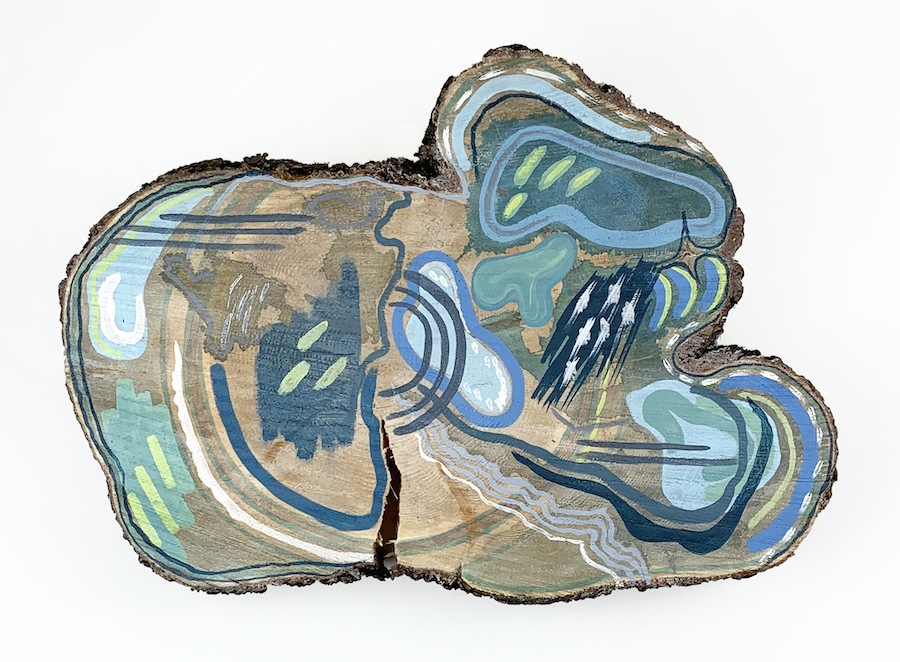
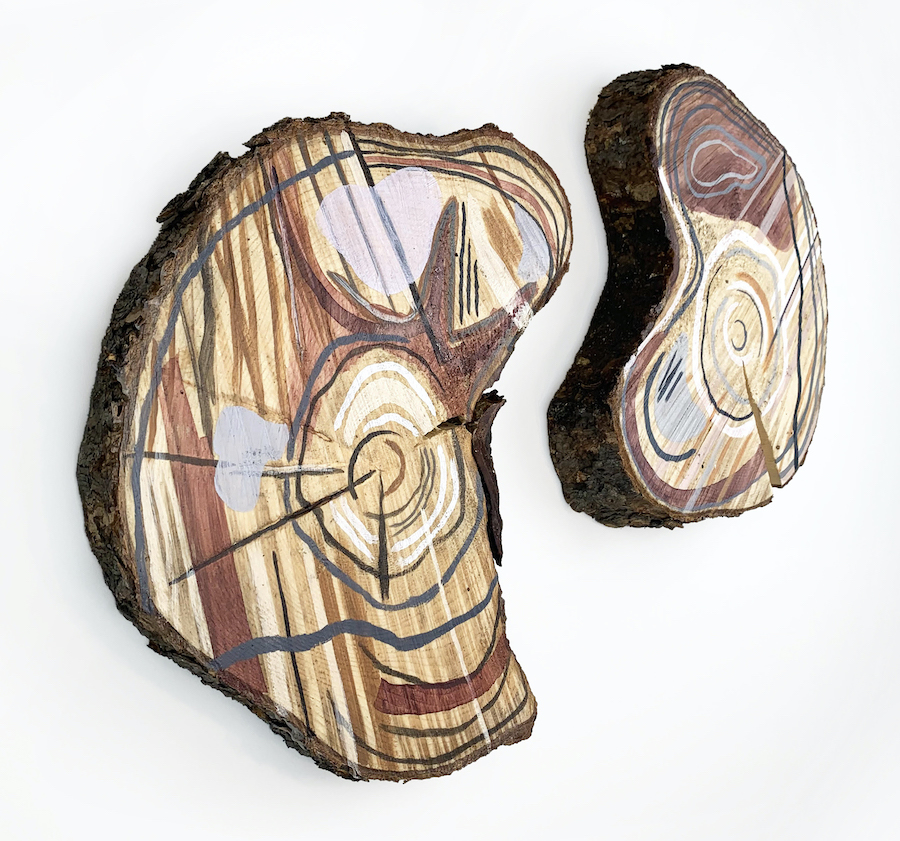
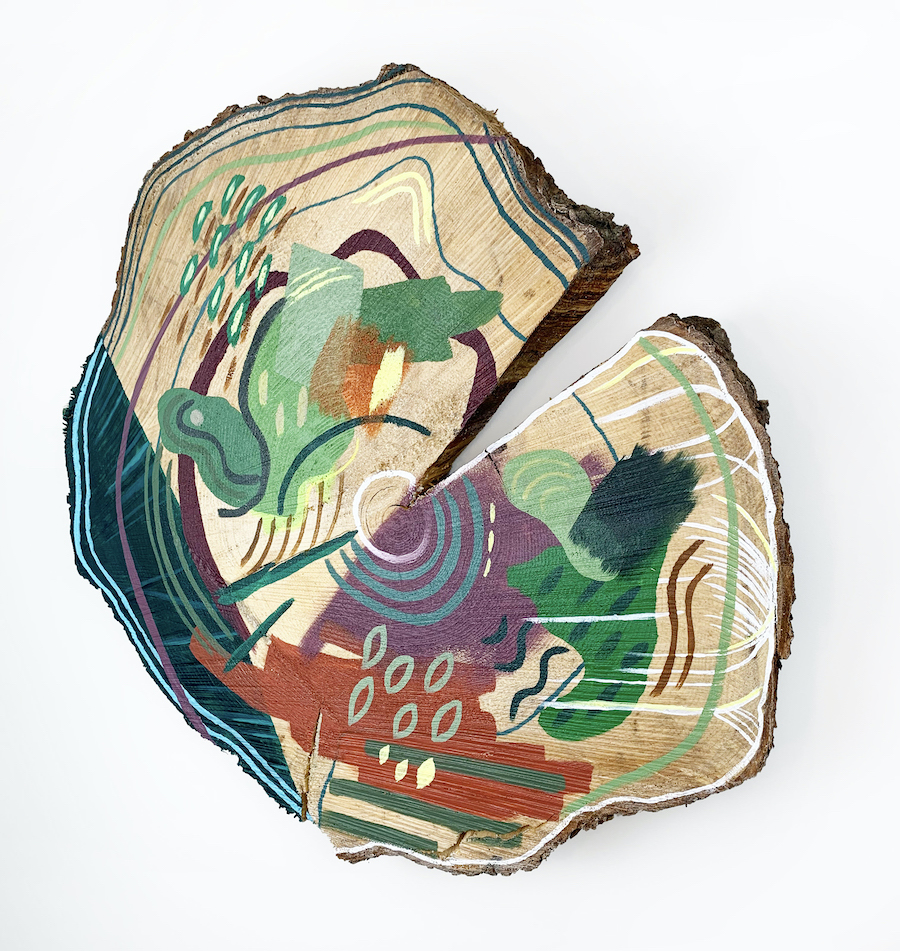
Tony Yu
Butoh is a form of Japanese dance referred to as the antithesis of western dance traditions. It is predominantly performed utilizing slow movement and can be defined as a dance where one discovers how to use their feet. Butoh does not surpass the human concept nor the ideals of a superhuman apprehension but, it asks us to assimilate ourselves through a different mentality.
My performance takes place outdoors which allows me to relate to my immediate environment and adheres to the Butoh ideology of being one with nature. Through slow and controlled movements, I travel through space and alter my audience’s perception of time. I aim to take them on a journey that encourages self-reflection while immersing ourselves in nature. When the performance starts, I am no longer myself but an anonymous performer who demonstrates expressions of all aspects that can be found in the human body.
I apply a dark and light thematic by employing personal experiences and memories from serving in the Korean military. These images serve as choreography for my movements and are directly transmuted into Butoh dance. These themes fuse together seamlessly in a manner where one cannot exist without the other.

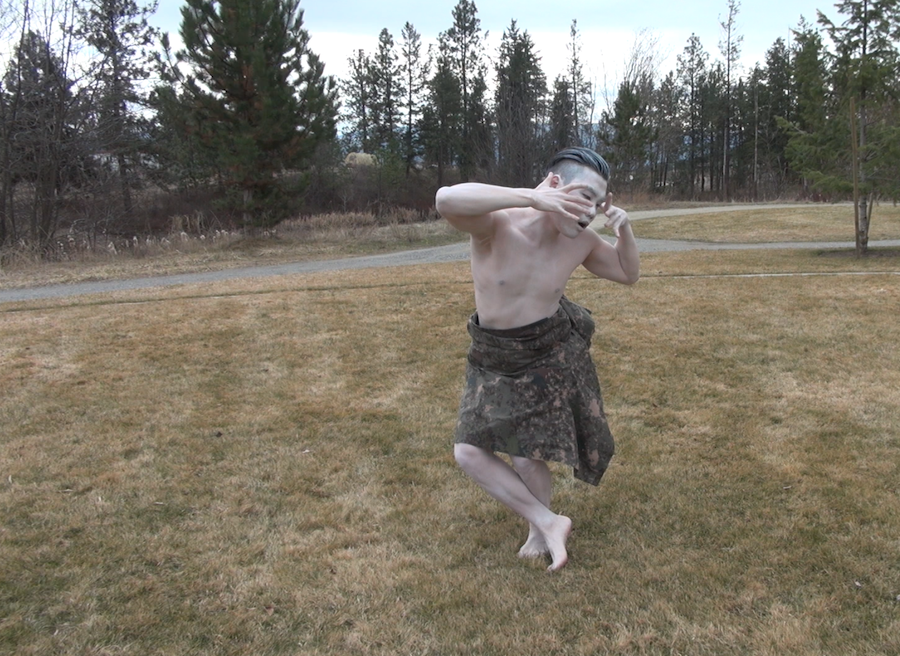
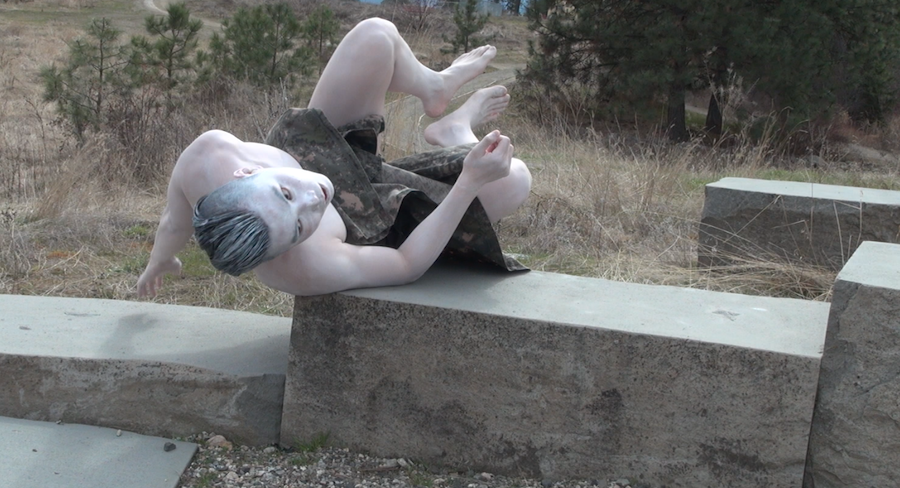

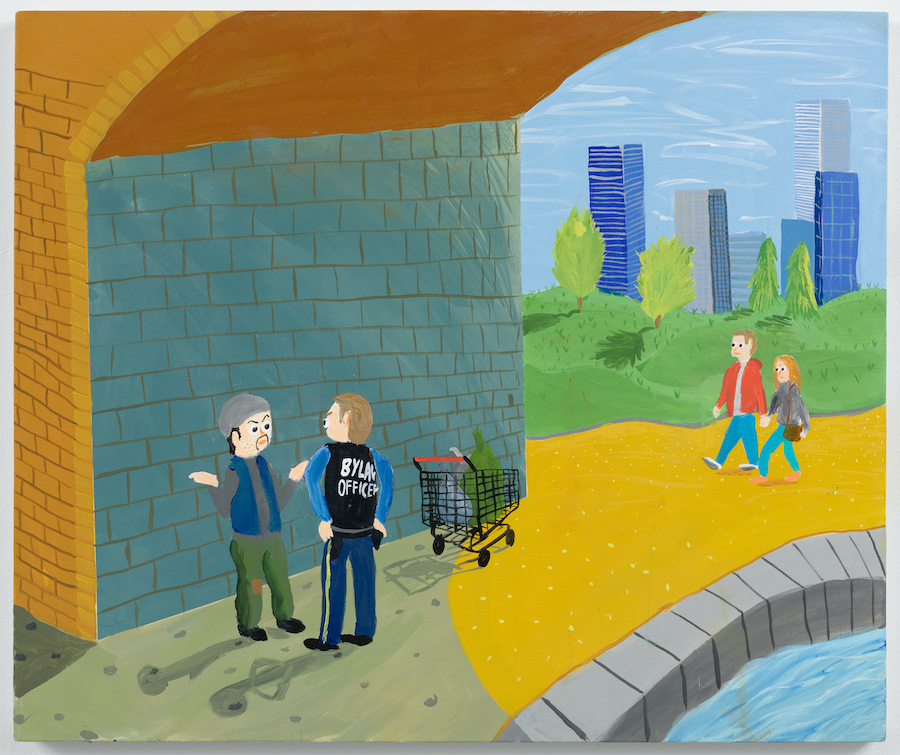
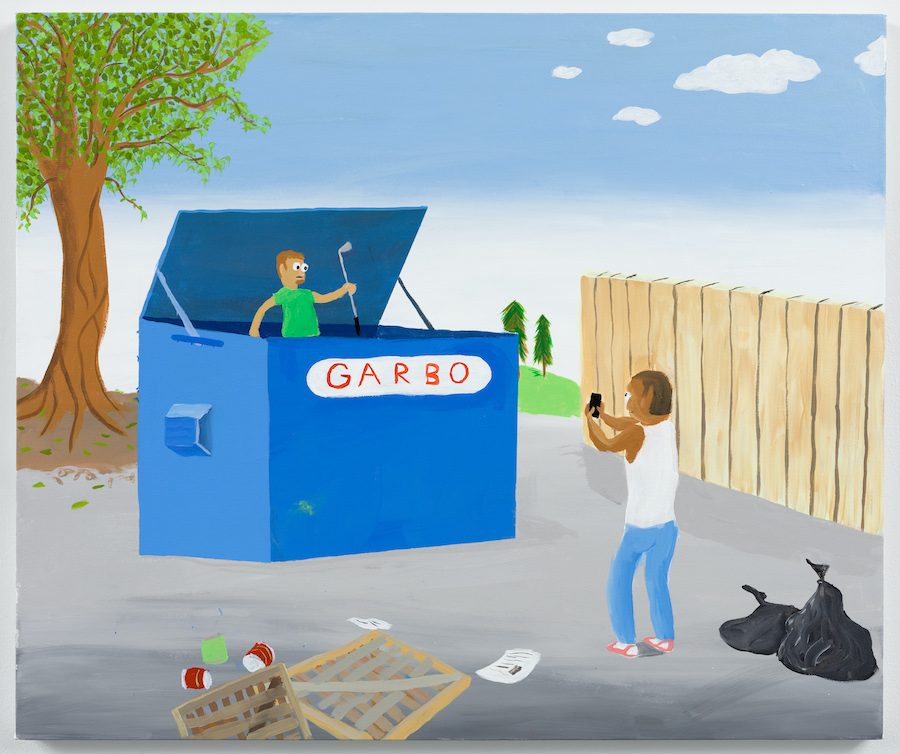
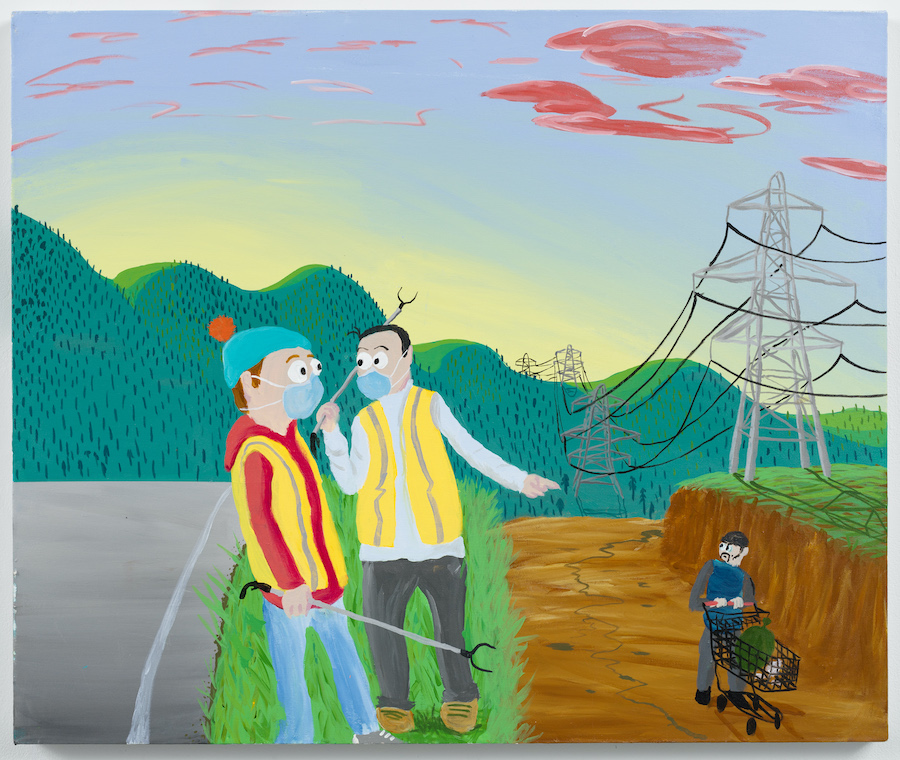
 Follow
Follow
